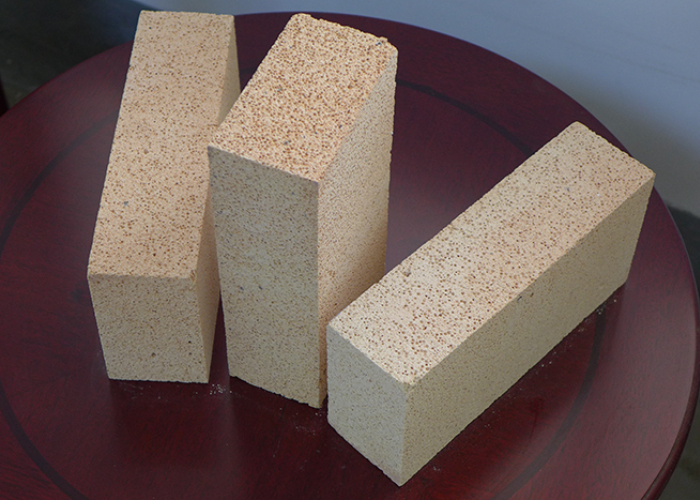Tijolos refratários com alto teor de alumina são um tipo de material refratário de silicato de alumina com um teor de óxido de alumina superior a 48%. É calcinado e formado pela matéria-prima da bauxita ou pelo material com alto teor de AL2O3. Alta estabilidade térmica, a refratariedade é superior a 1770 ℃. Boa resistência à escória, utilizado para revestimento de fogões elétricos de alvenaria siderúrgica, fornos de vidro, e revólveres de cimento.
Se o Al2Ó3 o teor de tijolo refratário de alta alumina é maior do que 90%, é chamado de tijolo de corindo. Devido a diferentes recursos, os padrões de diferentes países não são completamente consistentes. Por exemplo, em países europeus, o limite inferior de Al2Ó3 o conteúdo para refratários com alto teor de alumina é 42%. Na China, Al2Ó3 o conteúdo em tijolos com alto teor de alumina é geralmente dividido em três graus: Grau I – Al2Ó3 contente > 75%; grau II – Al2Ó3 o conteúdo é 60-75%; grau III – Al2Ó3 o conteúdo é 48-60%.
Índice Físico e Químico de Tijolos Refratários de Alta Alumina
| Item | Propriedades | |||||
| RS-80 | RS-75 | RS-65 | RS-55 | RS-48 | ||
| Al2O3(%) | 80 | ≥75 | ≥65 | ≥55 | ≥48 | |
| Refratariedade(°C ) | ≥1790 | ≥1790 | ≥1790 | ≥1770 | ≥1750 | |
| Densidade aparente(g/cm3) | 2.65 | 2.5 | 2.45 | 2.4 | 2.3 | |
| Temperatura de amolecimento sob carga(°C ) | 1530 | ≥1520 | ≥1500 | ≥1470 | ≥1420 | |
| Taxa de mudanças lineares de reaquecimento (%) | 1500°CX2H | 0.1 | 0.1 | 0.1 | 0.1 | 0.1 |
| 1450°CX2H | -0.4 | -0.4 | -0.4 | -0.4 | -0.4 | |
| Porosidade aparente (%) | 22 | ≤23 | ≤23 | ≤22 | ≤22 | |
| Força de esmagamento a frio (MPa) | 55 | ≥50 | ≥45 | ≥40 | ≥35 | |
Vantagens dos tijolos com alto teor de alumina
- Forte resistência a altas temperaturas: O principal componente dos tijolos com alto teor de alumina é a alumina, portanto, eles têm resistência a temperaturas extremamente altas e geralmente podem suportar temperaturas acima 1500 graus Celsius.
- Boa resistência à corrosão: Tijolos com alto teor de alumina têm forte resistência à corrosão química, como ácida e alcalina, por isso são frequentemente usados em ambientes em contato com meios corrosivos, como a indústria metalúrgica, indústria de vidro, etc..
- Forte resistência ao choque térmico: Devido à sua composição e estrutura únicas, tijolos com alto teor de alumina têm boa resistência ao choque térmico e podem suportar mudanças rápidas de temperatura.
- Baixa condutividade térmica: Comparado com outros materiais refratários, tijolos com alto teor de alumina têm baixa condutividade térmica, o que os torna vantajosos em algumas aplicações industriais especiais, como camadas de isolamento térmico dentro de fornos de alta temperatura.
- Alta resistência: Tijolos com alto teor de alumina têm alta resistência à compressão e podem suportar grandes tensões mecânicas.
- Boa estabilidade de volume: Tijolos com alto teor de alumina não são propensos a mudanças significativas de volume em ambientes de alta temperatura, o que os torna amplamente utilizados em fornos industriais e outras ocasiões.
- Forte resistência ao desgaste: Tijolos com alto teor de alumina têm alta dureza superficial e forte resistência ao atrito e impacto de alguns materiais particulados.
- Não é facilmente contaminado: A superfície dos tijolos com alto teor de alumina não é facilmente contaminada, o que os torna amplamente utilizados em alguns campos industriais que exigem alta pureza do produto.
A diferença entre tijolos pesados com alto teor de alumina e tijolos leves com alto teor de alumina
1. Diferentes processos de produção

Tijolos pesados com alto teor de alumina usam clínquer com alto teor de alumina como principal matéria-prima, e argila macia e lama residual como agente aglutinante. Após moldagem de alta pressão, secagem, e queima em alta temperatura.
Tijolo leve com alto teor de aluminas são feitos misturando clínquer de bauxita com alto teor de alumina com aglutinante e agente espumante, em seguida, fundindo e finalmente queimando em alta temperatura.
Tanto os tijolos pesados com alto teor de alumina quanto os tijolos leves com alto teor de alumina requerem sinterização em alta temperatura, mas um usa moldagem de alta pressão, e o outro usa moldagem por fundição.

2. Diferentes densidades de volume

A densidade de volume de tijolos pesados de alta alumina é 2,3-2,65G/CM3, a densidade do volume é densa, e a porosidade é baixa, menor que 23%.
A densidade de volume de tijolos leves de alta alumina é 0,6-1,5G/CM3, a densidade do volume é pequena, e a porosidade é maior que 45%

3. Diferentes temperaturas refratárias

A faixa de temperatura resistente ao fogo de tijolos pesados de alta alumina é 1580-1790 graus, e eles têm boa resistência a altas temperaturas.
A temperatura de serviço dos tijolos leves com alto teor de alumina é inferior à dos tijolos pesados com alto teor de alumina., e a faixa de temperatura de serviço é de cerca de 1350-1500 graus.

4. Diferentes partes de uso

Tijolos pesados com alto teor de alumina têm temperatura operacional mais alta e podem ser usados em peças que estão em contato com escória. Eles têm baixa porosidade e forte capacidade anti-penetração.
Tijolos leves com alto teor de alumina têm baixa temperatura operacional e alta porosidade, não pode entrar em contato com chamas ou escória, e são usados principalmente para camadas de isolamento térmico.

 Grupo Rong Sheng
Grupo Rong Sheng









WeChat
Digitalize o código QR com wechat